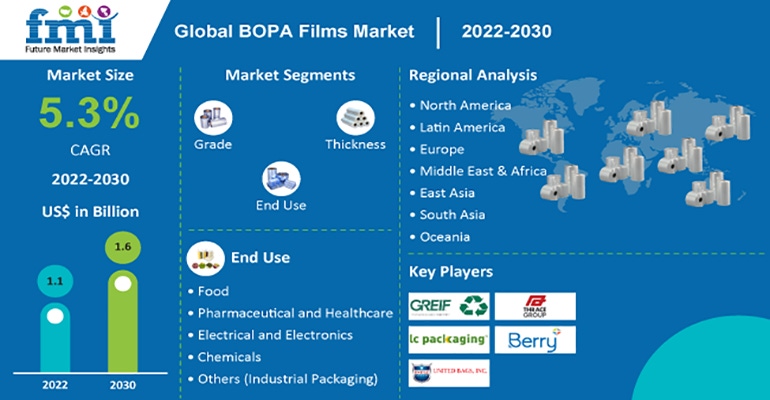Food packaging applications help support a CAGR of 5.3% for biaxially oriented polyamide (BOPA) films in the run-up to 2030, study says.
April 19, 2022

Food and pharmaceutical packaging applications, among others, will drive growth in the global market for biaxially oriented polyamide (BOPA) films between 2022 and 2030, according to recent research from Future Market Insights (FMI). Polyamide is better known as nylon.
FMI’s new “BOPA Films Market” report estimates the market for these nylon films will grow at a compound annual growth rate (CAGR) of 5.3% to become a $1.6 billion market by the end of the decade.
The food industry is predicted to be the largest end user of these films, controlling two-thirds the global market by 2030. BOPA films can be used to package products such as frozen and cooked food, meat and poultry, cheese, ready-to-eat foods, liquid and viscous food, liquid bag-in-box products, and produce.
Technologically advanced pharmaceutical packaging made from BOPA films — including next-generation blister packaging and blood and parenteral nutrition bags that can be serialized — is also expected to play an important role in the market’s growth.
Increased production of products requiring packaging formats such as stand-up pouches and single-dose packs (creams and soaps, for example) will also drive revenue gains in the BOPA films market.
“The demand for BOPA films in packaging is expected to increase in the years to come, as the companies opt for flexible [and] functional solutions at affordable pricing,” said an FMI research analyst in a prepared statement. The “beauty and cosmetic industry and rising demand for improved packaging in the pharmaceutical industry are also projected to give the BOPA market a shot in the arm.”
Demand for transparent packaging, particularly for food, will also aid in market growth. Multilayer BOPA films offer superior transparency, for showcasing food products. As an added benefit for food processors, transparent packaging reduces printing/labeling costs by reducing the area of the package that needs to be decorated.
The lingering impact of the COVID-19 pandemic is expected to influence the BOPA films market both positively and negatively. Consumer preference for packaged food products, for hygienic reasons, has had a short-term positive affect on the market. But at the same time, the pandemic has disrupted BOPA films production, raw material procurement, and supply to end users.
In terms of technical specifications, the preferred thickness in manufacturing BOPA films is 11 to 20 microns, and these thicknesses are expected to represent 60% of the global market by the end of 2030. Additionally, nylon 6 represents a substantial slice of market share among BOPA films; end users prefer this grade for its high-impact strength and easy orientation from both axes.
Regionally, FMI expects East Asia to represent an incremental opportunity of $241.4 million for BOPA films by the end of 2030. Major BOPA films manufacturers in this region include Unitika, Mitsubishi, and Toray.
You May Also Like


